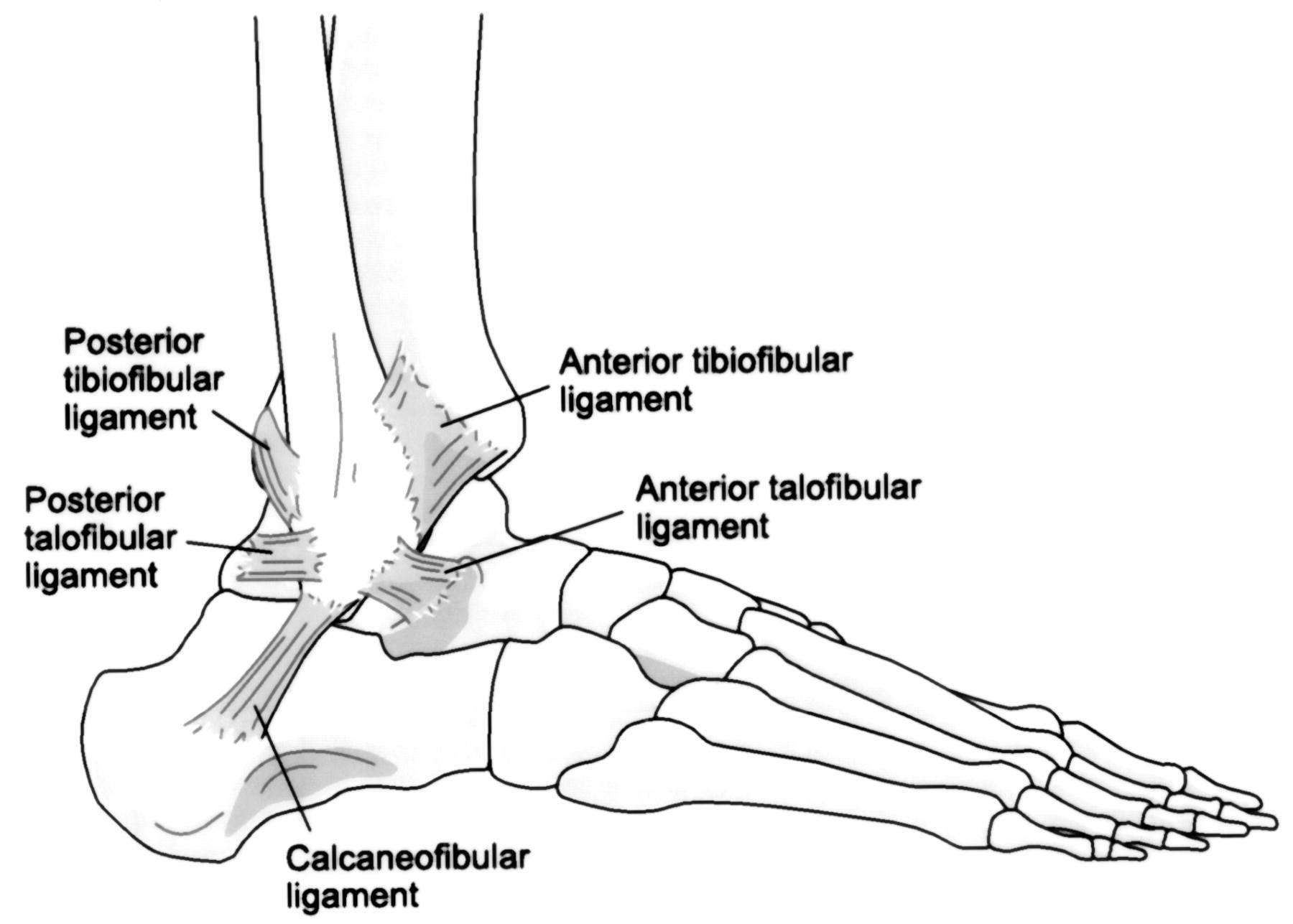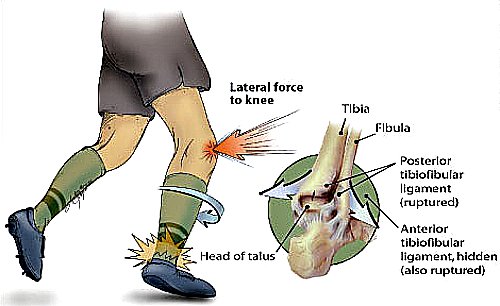Ankle Injury

Ankle Injury Introduction
Ankle injury is one of the most common sports injuries, often reoccurring again and again throughout the athletes playing career.
Almost
every injury to the ankle happens when the ankle is rolled outwards,
causing damage to the ligaments on the outside of the ankle.
Most soccer players have twisted their ankle at least once, considering that rolled ankle is one of the top soccer injuries that can happen to players.
This article will help players diagnose the severity of the ankle sprain and the treatment required for quicker recovery.
What is a sprained ankle?
Sprained or twisted ankle is stretching or tearing of the ankle ligaments, causing swelling of the ankle joint, and pain in the ankle area when trying to walk or run.
The discomfort in the ankle area will depend on the severity of the ankle injury.
Most common ankle sprain is the inversion sprain.
Inversion Ankle Injury - Most Common
Inversion ankle sprain occurs when the ankle is turned so
that the sole of the foot is turned inside, causing the ligaments on the
outside of the ankle to be stretched too far, or completely torn off, depending on how severe the ankle was twisted.
Swelling and discoloring are the main symptoms for inside ankle roll or sprain.
Eversion Injury
Eversion ankle sprain is very rare, but it does happen to athletes.
Eversion ankle sprain occurs when the athlete twists the ankle so that the sole of the foot faces outwards, leading to stretching or tearing of the ligaments located inside of the ankle joint.
In many cases, eversion ankle sprain will also have a fracture to the fibula bone in the lower leg.
It is recommended to see a doctor right away when an eversion ankle sprain occurs.
High Ankle Injury

High ankle sprain is another more serious injury to the ankle.
High ankle sprain occurs with a sudden twist of the foot, while the foot is planted, causing injury to the ligaments that join Tibia and Fibula together (right above ankle).
This type of injury is rare, and is associated with a fracture to the lower leg bone (fibula).
Soccer Ankle Sprain
Grade I
Grade I occurs when the foot is rolled inwards or outwards only for a moment, before recovering the foot back.
This causes minor stretching of the ankle ligament.
Athlete should be able to continue playing with little, to no discomfort in the ankle area.
- There shouldn't be any joint instability with Grade I ankle sprain.
- Pain may be noticeable when the injury first occurs.
- Little to no pain should be felt when walking or running, after Grade I ankle sprain or twist.
- Mild ankle swelling around the bone should be expected.
- Ankle joint stiffness, causing mild pain when running or walking, once the body temperature cools down.
Rice Method (Rest, Ice, Compress, Elevate) for speedy recovery.
Soccer Ankle Injury
GRADE II
Grade II sprained ankle will cause moderate tearing of the ankle ligament fibers, leading to instability of the ankle joint.
- Moderate to severe pain and difficulty walking is to be expected with Grade II ankle sprain.
- Athlete is unlikely to be able to play on.
- Noticeable limp when walking.
- Torn ligament fibers cause ankle swelling and stiff ankle joint.
- Minor bruising along with swelling is to be expected.
Rice Method (Rest, Ice, Compress, Elevate) for ankle sprain recovery.
Soccer Ankle Sprain
GRADE III
Grade III ankle sprain usually results in a total, or almost complete rupture of the ankle ligament.
- Severe pain at the time of injury and afterwards.
- Instant, extensive swelling and bruising on the ankle.
- Total instability of the ankle joint.
- Inability to walk or put any pressure on the ankle.
- Doctors Office visit is the best option for long term ankle problem prevention.
Rice Method (Rest, Ice, Compress, Elevate) for any ankle sprain recovery.
Scroll down for treatment and rehabilitation of ankle injuries.
For more information about ankle injuries visit Sports Injury Clinic - Ankle Sprain.

| Soccer Related Injuries & More |
|---|
| ACL Injuries ACL or Anterior Cruciate Ligament is one of four knee ligaments holding the knee joint together. |
| ACL Injury Recovery ACL Injury Recovery will be needed after every ACL ligament tear or mild sprain. |
| Ankle Sprain Treatment Causes for ankle sprain can range from playing sports and forcefully rolling the ankle to just taking a walk in the park and twisting your ankle when stepping down from a curb :( |
| Common Soccer Injuries I wanted to create one web page with information on common soccer injuries and what these injuries feel like so that you can sometime recognize what is going on when it does happen to you or your players. |
| Hamstring Exercises Many athletes and regular people have hurt their hamstring at one point in their life and know how discomforting a hurt hamstring can feel. |
| Treatment for Injured Hamstring Hamstring injury treatment will vary depending on the severity of the injury. |
| Hamstring Injury Hamstring muscle injuries occur very frequently in athletes participating in various physically demanding sports that require sprinting and sudden change of movement and speed. |
| Hamstring Stretches Stretching the hamstring muscles is very important for our overall health as it reduces lower back pain and gives us strong and lean hamstrings that will help with our lower body range of motion. |
| High Ankle Sprain Ankle Syndesmosis injuries are often referred to what people call high ankle injury due to ankle swelling and ankle joint pain in the ligaments above the ankle. |
| How To Tape Your Ankle Ankle taping is a big part of preventing ankle injury for players participating in any type of sport where running and change of direction is required, such as soccer, football, basketball etc. |
| Knee Injuries in Soccer Knee injuries are very common in sports that require running and change of direction. Soccer is one of many sports where ligament injuries have a chance to sideline the player for longer periods of time. |
| LCL Knee Injury LCL (lateral collateral ligament) is one of the four knee ligaments holding the knee in place. |
| LCL Injury Recovery When it comes to LCL ligament injury, time is the best healing process and surgery is rarely required for treatment of common lateral collateral ligament injuries. |
| MCL Knee Injury MCL or Medial Collateral Ligament is one of the FOUR major ligaments that hold the knee together preventing it from sliding left and right or back and forth. |
| MCL Injury Recovery MCL rehab is needed after an MCL ligament injury and time is the best friend in getting over the MCL knee injury. |
| PCL Knee Injury PCL ligament crosses with the ACL ligament preventing our knee from moving back and forth. |
| PCL Injury Recovery PCL injury rehab will be different depending on the level or degree of knee injury suffered. |
| Ankle Injury Most sport players have twisted their ankle at least once considering that rolled ankle is one of the top sport injuries so I decided to cover everything about ankle sprain in this article. |
| Concussion Symptoms What is a concussion? Concussion is a traumatic head injury that occurs from mild or severe blow to the head. |
| Concussion Treatment Following a concussion, rest is the best answer for concussion treatment. |